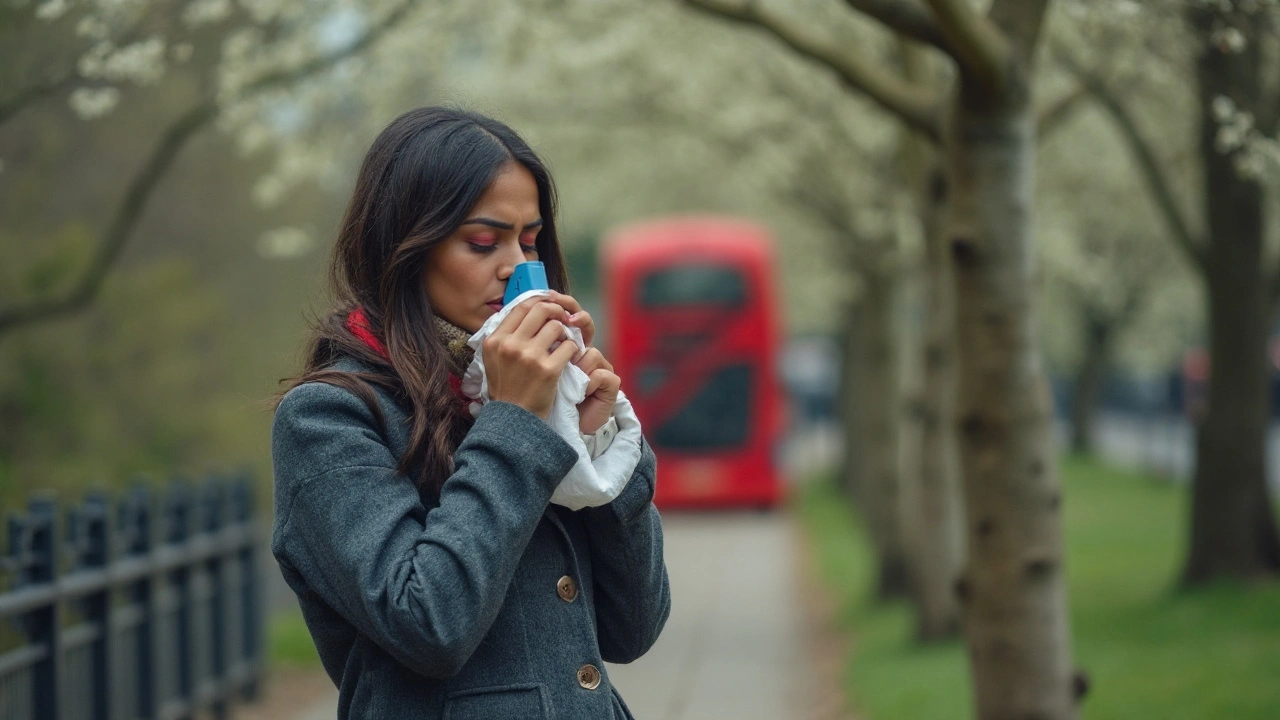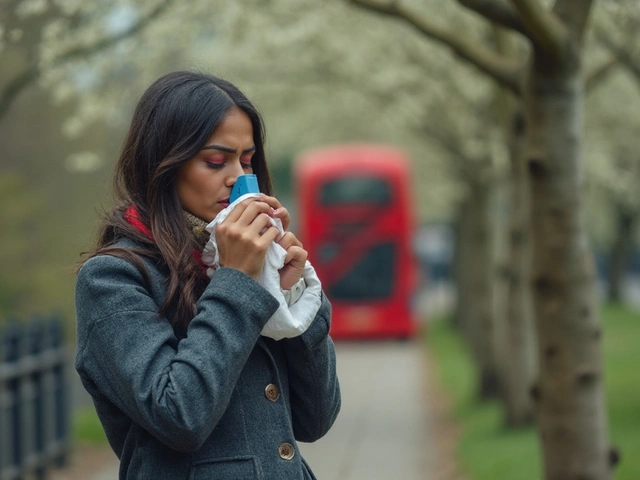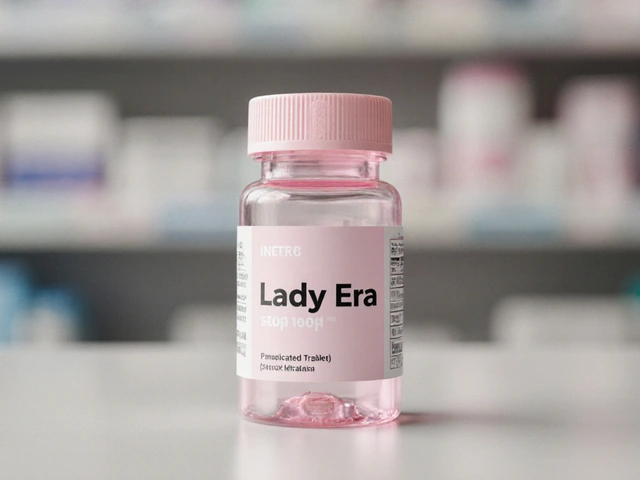You’re wheezing again, your nose is blocked, and your eyes look like you pulled an all-nighter. That isn’t bad luck-it’s one connected problem. When your nose and eyes flare, your lungs usually follow. Ignore the upper symptoms and your inhaler works harder, your sleep gets worse, and flare-ups pop up at the worst times. I’ve been there-mowing the lawn, petting my Labrador, Molly, and suddenly I’m coughing, my eyes burning, and my chest tight. The good news: once you treat the whole airway, asthma gets much easier to control.
TL;DR: the nose-eye-lung link and what to do now
- The same allergy process that inflames your nose and eyes (allergic rhinitis and conjunctivitis) also inflames your lower airways-this is the “one airway” idea supported by ARIA and GINA guidelines.
- When your nose is blocked, you mouth-breathe cold, dry, allergen-filled air, which irritates the lungs and can trigger asthma symptoms and attacks.
- Treating nasal and eye allergies improves asthma control. Expect fewer night symptoms, less rescue inhaler use, and fewer flare-ups when you treat both.
- Quick start: daily intranasal steroid spray, saline rinses, an as-needed non-drowsy antihistamine, and evidence-based asthma therapy (per GINA 2025, low-dose ICS-formoterol as needed for many adults/adolescents). Add allergy eye drops if eyes are red and itchy.
- Red flags: wheeze that doesn’t ease after your reliever, lips or fingernails turning blue, trouble speaking full sentences, ribs sucking in, or peak flow under 50% of your best-call emergency services.
How your nose, eyes, and lungs are connected
Think of your airways as one long hallway. The nose is the front door, the lungs are the back rooms, and the immune system is the over-eager security guard. If pollen, dust mites, pet dander, or mold sneak through the front door, the whole hallway gets riled up. Cells in the lining release histamine and cytokines that don’t stop at the nose and eyes-they ripple down to the bronchi. That’s why you can go from sneezing to wheezing in an hour.
Two things make it worse. First, a blocked nose pushes you to breathe through your mouth. Mouth-breathing bypasses your nose’s filter and humidifier, so cold, dry, unfiltered air hits the lungs and tightens the airways. Second, drainage from the nose (postnasal drip) irritates the throat and triggers cough and bronchospasm. This is classic in spring and fall but can hit year-round if your triggers live indoors.
Guidelines back this up. The ARIA (Allergic Rhinitis and its Impact on Asthma) consensus and GINA (Global Initiative for Asthma) reports say treating upper-airway allergic inflammation can improve asthma outcomes-fewer symptoms, improved sleep, and fewer exacerbations. In real life, I see this play out when someone finally treats their nasal stuffiness daily; two weeks later, their rescue inhaler starts collecting dust.
Is it allergies or a cold? A cold usually brings fever, sore throat at the start, body aches, and thick, yellow-green mucus after a couple of days. Allergies tend to itch-eyes, nose, roof of the mouth-plus sneezing fits, clear watery discharge, and symptoms that track with exposure (fresh-cut grass, a dusty closet, your friend’s cat). If the eyes are burning, watery, and red without much pain, and you’re rubbing them, that screams allergy more than infection.
Common triggers and telltale patterns:
- Pollens (trees in spring, grasses in late spring/summer, weeds in late summer/fall): symptoms flare outdoors, worse on windy mornings, better after rain.
- Dust mites: worse at night or after making the bed; year-round.
- Pets: flare-ups minutes to hours after exposure. Yes, even “hypoallergenic” breeds carry dander.
- Mold: damp rooms, basements, bathrooms; musty smell is a clue.
- Smoke, fragrances, and cleaning sprays: not allergens but irritants that can tip you over.
Comorbid troublemakers: chronic sinusitis, nasal polyps, reflux, and sleep apnea all worsen control. If you snore hard, wake unrefreshed, or have smell loss or facial pressure, bring this up at your visit. Fixing these often calms the lungs.

Step-by-step plan: what to do this week to breathe easier
Here’s a practical, evidence-based plan you can start today. Keep it simple and consistent for two to four weeks-you should feel a real difference.
-
Day 1: Set your baseline and pick your tools.
- Write down current symptoms: daytime cough/wheeze, night waking, blocked nose, eye itch/redness, rescue inhaler use, and any triggers you notice. If you have a peak-flow meter, record morning and evening values for a week.
- Asthma reliever plan (adults/adolescents): Many can use low-dose ICS-formoterol as needed (GINA 2025). If you’re on a different plan (e.g., SABA-only), talk to your clinician-SABA-only is no longer preferred for most.
- For the nose: start a once-daily intranasal corticosteroid (fluticasone, mometasone, triamcinolone, budesonide). Give it 1-2 weeks for full effect.
- For the eyes: add an antihistamine/mast-cell stabilizer drop (ketotifen OTC, olopatadine OTC or prescription) once or twice daily.
- For itch/sneeze: keep a non-drowsy oral antihistamine (cetirizine, fexofenadine, loratadine) on hand. Use on high-exposure days.
-
Learn the right technique.
- Nasal spray: look slightly down, spray outward (toward the ear), avoid the septum, don’t sniff hard. Two sprays per nostril daily to start.
- Inhaler: check your spacer or device technique; wrong technique can waste half the dose. Your pharmacist can watch and coach in 2 minutes.
- Saline rinse: use sterile or boiled-then-cooled water only. Rinse at night to wash allergens away and unblock the spray’s path.
-
Control the triggers that hit you hardest.
- Pollens: keep windows shut on high-count days, run central AC or a HEPA purifier in the bedroom, shower after outdoor time, sunglasses and a hat help keep pollen out of eyes.
- Dust mites: zippered allergen covers for pillows and mattress, wash bedding weekly in hot water, keep humidity 40-50%, reduce bedroom clutter and fabric piles.
- Pets: keep pets out of the bedroom, HEPA purifier, bathe dogs weekly if tolerated. I love Molly, but she stays off my bed during grass season.
- Mold: fix leaks, vent bathrooms, use a dehumidifier in damp areas, clean visible mold safely or call a pro for big jobs.
- Irritants: skip candles, incense, and strong spray cleaners; choose unscented products.
-
Use meds smartly and safely.
- Intranasal steroids are safe long term at standard doses and don’t cause dependence. Aim for daily use during your season (or year-round if perennial symptoms).
- Oral decongestants (pseudoephedrine) can help short term but can raise blood pressure, worsen anxiety, and disturb sleep. Avoid if pregnant, hypertensive, or with prostate issues.
- Nasal decongestant sprays (oxymetazoline) relieve congestion fast, but limit to 3 days to avoid rebound congestion.
- Montelukast can help with both asthma and allergies but carries an FDA boxed warning (2020) for possible mood and behavior changes; discuss risks/benefits with your clinician.
- If your asthma needs daily control, you may be on an inhaled corticosteroid (ICS) or ICS/LABA. Follow your action plan; don’t stop controllers just because you feel better this week.
-
Line up testing and a plan.
- Schedule a visit if you’re needing your reliever more than twice a week, waking at night, or your peak flow is variable.
- Ask about allergy testing (skin-prick or blood specific IgE) if you’re not sure what’s triggering you. Knowing your target helps with avoidance and immunotherapy decisions.
- Discuss an asthma action plan with green/yellow/red zones tied to symptoms and peak flow. Agree on when to start oral steroids and when to seek urgent care.
-
Think long-term: immunotherapy and biologics.
- Allergen immunotherapy (shots or sublingual tablets for some pollens/dust mites) retrains your immune system. It’s a 3-5 year commitment but can reduce symptoms and meds. Good fit if you have clear triggers and can stick with it.
- Severe asthma with allergies or high eosinophils can benefit from biologics (e.g., omalizumab, dupilumab, mepolizumab, benralizumab, tezepelumab). These are specialist-prescribed and can cut exacerbations significantly.
Where does the evidence come from? The GINA 2025 report, the ARIA guidelines, the NAEPP 2020 Focused Updates, and position statements from AAAAI and ACAAI. They converge on one message: treat the whole airway, not one room at a time.
Scenarios, examples, and rules of thumb
“Every time I mow, I’m a mess.” Wear wraparound sunglasses and a brimmed hat. Pre-treat 20-30 minutes before with your non-drowsy antihistamine and your prescribed reliever if you’re exercise-sensitive. Shower and change right after. Consider a pollen-filtering mask if mowing is non-negotiable.
“I wake stuffed up at 2 a.m. and wheeze by 3.” Classic dust mite pattern. Add allergen covers, wash bedding weekly hot, and run a HEPA purifier in the bedroom. Start nightly nasal steroid plus saline rinse. Many people notice fewer night wheezes within two weeks.
“My eyes pour at my kid’s soccer field.” That’s likely grass pollen. Use antihistamine eye drops before you go, wear sunglasses, and keep a spare eyelid wipe in the bag. Avoid rubbing; it releases more histamine and can make it worse.
“I’m fine at home, bad at work.” Think workplace triggers-old carpet (dust mites), printers/toner, fragrances, or cleaning sprays. Ask for fragrance-free policies, better ventilation, or a desk move away from printers. Track symptoms by location in your notes.
“I moved in with a partner who has a cat.” Start strict bedroom avoidance, upgrade filtration, and rinse sinuses nightly. Talk about immunotherapy; cat allergy tends to be tough without it.
“I get chest tightness only when I run.” Exercise-induced bronchoconstriction often sits on top of mild allergy inflammation. Treat the nose, then use your prescribed reliever before workouts. Warm up 10-15 minutes and prefer humid, warm air if possible.
“I’m pregnant-what’s safe?” Many intranasal steroids (e.g., budesonide) and second-generation antihistamines have reassuring safety data in pregnancy; always confirm with your obstetric clinician. Uncontrolled asthma is riskier for baby than most standard treatments.
“My kid can’t sleep for coughing when school starts.” Back-to-school brings viral spread plus ragweed or mold. Tighten sleep routines, daily nasal steroid, and check their inhaler technique. Share an action plan with the school nurse. Kids often underreport symptoms-watch night cough and playtime stamina.
Rules of thumb:
- If it itches, think allergy. If it aches, think infection.
- Congestion-only relief from a decongestant is not control. You need anti-inflammation (nasal steroid, ICS for asthma).
- Start allergy control two weeks before your usual season; don’t wait for day one of symptoms.
- When symptoms cluster-blocked nose, red watery eyes, plus wheeze-treat all three together for the next 2-4 weeks.
- If you need your reliever more than twice a week or wake at night, step up and ask for a review.

Checklists, mini-FAQ, and next steps
Home allergy-control checklist
- Bedroom: allergen covers for pillows/mattress, weekly hot wash, low-clutter, HEPA purifier, no pets inside the bedroom.
- Air: windows closed on high pollen days, central AC on recirculate, clean/change filters as recommended.
- Humidity: target 40-50%; use dehumidifier in damp rooms.
- Floors: vacuum with a HEPA machine; if you notice symptoms during vacuuming, wear a mask and air out.
- Bathroom/basement: fix leaks, vent showers, scrub visible mold safely.
Medication game plan
- Nasal: daily steroid spray; saline rinse at night; consider adding an intranasal antihistamine if strong symptoms (azelastine with or without steroid).
- Eyes: antihistamine/mast-cell stabilizer drops; cool compresses; avoid contacts during bad flares.
- Asthma: evidence-based reliever (often ICS-formoterol) and controller if prescribed; check inhaler technique monthly.
- Emergency: keep your reliever with you; know your action plan doses.
Doctor visit checklist
- Bring a 1-2 week symptom diary and peak-flow readings if you have them.
- List of triggers you suspect and places you feel worse.
- All meds and devices you use, with exact names/doses; snap photos if easier.
- Ask: Do I qualify for allergy testing? Should I consider immunotherapy? Is my asthma plan aligned with GINA 2025? Do I need screening for sinusitis, polyps, reflux, or sleep apnea?
Travel/commute kit
- Reliever inhaler (and spacer if you use one).
- Non-drowsy antihistamine tablets.
- Small saline spray or single-use vials.
- Antihistamine eye drops.
- Tissues and a pair of wraparound sunglasses.
Red flags-don’t wait
- Reliever isn’t helping or wears off under 2 hours.
- Hard to talk in full sentences, ribs pulling in, bluish lips/fingertips.
- Peak flow under 50% of your personal best.
- Sudden severe eye pain, light sensitivity, or vision changes-this points to something other than simple allergy.
Mini-FAQ
- Can allergies cause asthma? Not exactly “cause,” but they set the stage. Many people with persistent asthma also have nasal/eye allergies, and allergic inflammation can trigger asthma flares. ARIA and GINA call this the “united airway.”
- Will treating my nose help my lungs? Often, yes. Studies show better asthma control and sleep when nasal symptoms are managed with intranasal steroids and antihistamines.
- Are steroid nasal sprays safe? At standard doses, they’re considered safe for long-term use. They act locally with minimal systemic absorption. Nosebleeds can happen; fix your technique and aim away from the septum.
- Is montelukast worth it? It can help some people with both asthma and rhinitis, but it carries an FDA boxed warning for neuropsychiatric events. Use it when the potential benefit is clear and discuss risks upfront.
- Are neti pots safe? Yes, with sterile technique. Use distilled, sterile, or boiled-and-cooled water. Rinse the device and let it air-dry fully.
- Do biologics replace inhalers? No. They’re add-ons for moderate-to-severe asthma to reduce attacks. You usually continue inhaled therapy.
- Can kids outgrow this? Some do, but many continue to have seasonal symptoms. Good control in childhood protects sleep, growth, and school performance.
- Is this different in 2025? The direction keeps moving toward anti-inflammatory reliever strategies (like ICS-formoterol as needed) and earlier recognition of the nose-lung link. More biologic options are available, tailored by biomarkers.
Next steps and troubleshooting by persona
- Busy parent with a child who wheezes each spring: Put a daily reminder for nasal spray, pre-load the school with an action plan, and start meds two weeks before pollen season. Ask about dust mite covers if night cough is common.
- College student in a dorm: Grab a compact HEPA purifier, keep windows shut during peak pollen, and store bedding in zippered covers. Keep a travel kit in your backpack. Dorms are dusty; rinses help a lot.
- Outdoor worker: Talk to your employer about schedule tweaks on high-pollen mornings and using protective eyewear and masks. Pre-treat with meds per your action plan and plan rinse/shower breaks.
- Pet owner who’s allergic: Bedroom is a sanctuary-no exceptions. HEPA, weekly pet baths if feasible, and routine grooming outdoors. Consider immunotherapy if you won’t part with the pet-many don’t, and that’s okay with a plan.
- Runner training for a race: Warm up longer, run after rain when pollen drops, and use your prescribed pre-exercise med. If you’re still tight, address nasal control; it often unlocks your lungs.
You don’t need a perfect home or a pharmacy’s worth of bottles. You need a simple daily routine, clear triggers to avoid, and an action plan you actually use. Two weeks of consistent upper-airway treatment can change your nights and your lungs. That’s the quiet superpower most people miss when they only chase the wheeze.
References for guidance: GINA 2025 (Global Initiative for Asthma), ARIA (Allergic Rhinitis and its Impact on Asthma) updates, NAEPP 2020 Focused Updates, and practice parameters from AAAAI/ACAAI. They all point in the same direction-treat the whole airway, and you’ll breathe easier.








Christopher Pichler August 29, 2025
Congrats on discovering the “united airway”-who would've guessed that the nose and lungs actually talk to each other? Your TL;DR nails the ARIA and GINA synergy. The pathophysiology you outlined-post‑nasal drip, mouth‑breathing, histamine cascade-reads like a textbook but with a dash of real‑world grit. I appreciate the step‑by‑step plan; the day‑one baseline is especially practical. Just remember to calibrate your peak‑flow diary, because data beats anecdotes. Overall, solid guide with a sprinkle of sarcasm about inhaler dust collectors.
VARUN ELATTUVALAPPIL August 29, 2025
Wow!!!, you really dove into mucosal immunology, the cytokine storm, the histamine fireworks, the whole cascade-it's like a fireworks show in your sinuses, and I love it!!!, but maybe you could have tossed in a quick tip about allergen‑proof pillow covers, because that's what most of us actually need, period!!!
April Conley August 30, 2025
Allergic rhinitis is the gateway to asthma, period.
Sophie Rabey August 30, 2025
I love how you turned a mountain of guidelines into a checklist you can actually stick to-finally a plan that doesn't require a PhD to decode. The nasal steroid reminder is pure gold, especially for those of us who treat our inhaler like a fashion accessory. If you keep the saline rinse routine, post‑nasal drip will stop being the unwanted guest at every bedtime party. Keep it chill, keep it consistent, and those wheezy nights will be a thing of the past.
Bruce Heintz August 30, 2025
Exactly! 😄 A consistent routine is the secret sauce, and the little wins-like less snoring and clearer eyes-add up fast. Don't forget to celebrate each night you wake up without a cough; those victories keep motivation high! 👍
richard king August 30, 2025
Reading your comprehensive guide feels like stepping into an epic saga where the nose, eyes, and lungs are the reluctant heroes forced to unite against a common enemy. The villain, in this case, is a relentless army of pollen, dust mites, and mold spores, each armed with histamine grenades that explode across the mucosal battleground. You deftly illustrate how the upper airway’s inflammation sends shockwaves down the bronchial tubes, turning a mild sneeze into a full‑blown asthmatic flare. The notion of “mouth‑breathing as a cold‑air missile” is both vivid and scientifically accurate, reminding us that anatomy does not operate in isolation. By weaving the ARIA and GINA guidelines into a narrative, you transform dry policy into actionable strategy. The day‑one baseline you suggest-symptom diary, peak‑flow measurements, and trigger log-is a tactical reconnaissance that any seasoned commander would endorse. Your recommendation to start intranasal corticosteroids early mirrors a pre‑emptive strike, halting the inflammatory cascade before it reaches the lungs. Saline rinses serve as a diligent cleanup crew, sweeping away residual allergens that would otherwise regroup. The emphasis on environmental controls-HEPA filters, humidity regulation, allergen‑proof bedding-acts like fortifying the castle walls against siege. Moreover, your discussion of immunotherapy and biologics introduces advanced weaponry for the truly stubborn adversaries. The treatment hierarchy you present-start simple, then escalate-mirrors the classic “train‑up‑upgrade” model familiar to combat veterans. I also appreciate the candid warning about montelukast’s neuropsychiatric shadow, a reminder that even the best weapons have side effects. Your checklist format is a battlefield map that anyone can follow, eliminating confusion in the heat of an attack. The anecdotes about mowing the lawn and nighttime dust‑mite coughs ground the guide in everyday reality, making the stakes feel personal. In the end, your message is clear: treat the whole airway, or risk losing the war to chronic inflammation. This manifesto not only educates but empowers, turning patients into proactive commanders of their own health. Let’s hope more clinicians adopt this united‑airway doctrine before the next pollen season’s onslaught. The future of asthma control may well depend on the courage to treat the nose and eyes with the same intensity we reserve for the lungs.
Dalton Hackett August 30, 2025
You've crafted an impressively cinematic overview, and I find myself nodding along with each strategic analogy you deploy. In practice, however, the devil often lies in the day‑to‑day execution of those battle plans-especially when patients juggle work, school, and family obligations. For instance, the recommended nightly saline rinse can be skipped if the routine feels too cumbersome, which in turn undermines the entire cascade you describe. A practical tip is to keep a preffered pre‑filled squeeze bottle by the bedside, turning the rinse into a five‑second maneuver rather than a chore. Similarly, while HEPA filters are championed, many renters lack the authority to replace HVAC units, so portable units become indispensable. It's also worthwhile to emphasize that peak‑flow variability should be interpreted in context; a single low reading on a bad night doesn’t always signal treatment failure. Moreover, the psychological aspect-patients feeling discouraged when they still need their reliever-deserves as much attention as the pharmacologic regimen. By framing each step as a small victory, clinicians can maintain motivation and adherence. Finally, documenting trigger exposure with a simple checklist can reveal hidden culprits, such as a newly acquired houseplant that releases pollen. Your guide provides the map; these incremental adjustments ensure travelers don't get lost along the way.
William Lawrence August 30, 2025
Sure, just spray your nose and ignore the cat situation but hey who needs consistency when you can wing it.
Grace Shaw August 30, 2025
While I acknowledge the temptation to adopt an overly casual stance, it remains imperative to underscore the significance of comprehensive environmental control in the management of allergic asthma. The presence of domestic felines, for example, introduces a persistent source of Fel d 1 allergen, which can perpetuate upper and lower airway inflammation despite optimal pharmacotherapy. Empirical evidence, as elucidated in recent meta‑analyses, confirms that the mere relocation of the animal from the bedroom yields measurable reductions in nocturnal symptoms and rescue inhaler usage. Consequently, a structured mitigation strategy-comprising regular grooming, HEPA filtration, and the establishment of allergen‑free zones-should be integrated into any therapeutic plan. It is not a matter of mere convenience but of clinical necessity, as uncontrolled exposure may precipitate exacerbations that compromise pulmonary function. Moreover, patient education regarding the pathophysiological nexus between nasal obstruction, mouth‑breathing, and bronchoconstriction is essential to foster adherence. I therefore advocate for a disciplined, evidence‑based approach that harmonizes pharmacologic and environmental interventions, thereby optimizing outcomes for individuals burdened by the united airway syndrome.
Sean Powell August 30, 2025
Yo the guide is fire keep that spray on deck and dont forget da mask when you mow the lawn its a game changer